
A fence is a structure that encloses an area, typically outdoors, and is usually constructed from posts that are connected by boards, wire, rails or netting. A fence differs from a wall in not having a solid foundation along its whole length.

Barbed wire, also known as barb wire, is a type of steel fencing wire constructed with sharp edges or points arranged at intervals along the strands. Its primary use is the construction of inexpensive fences, and it is also used as a security measure atop walls surrounding property. As a wire obstacle, it is a major feature of the fortifications in trench warfare.

In agriculture, fences are used to keep animals in or out of an area. They can be made from a wide variety of materials, depending on terrain, location and animals to be confined. Most agricultural fencing averages about 4 feet (1.2 m) high, and in some places, the height and construction of fences designed to hold livestock is mandated by law.
In horse racing in the United Kingdom, France and Republic of Ireland, National Hunt racing requires horses to jump fences and ditches. National Hunt racing in the UK is informally known as "jumps" and is divided into two major distinct branches: hurdles and steeplechases. Alongside these there are "bumpers", which are National Hunt flat races. In a hurdles race, the horses jump over obstacles called hurdles; in a steeplechase the horses jump over a variety of obstacles that can include plain fences, water jump or an open ditch. In the UK, the biggest National Hunt events of the year are generally considered to be the Grand National and the Cheltenham Gold Cup.

Kraal is an Afrikaans and Dutch word, also used in South African English, for an enclosure for cattle or other livestock, located within a Southern African settlement or village surrounded by a fence of thorn-bush branches, a palisade, mud wall, or other fencing, roughly circular in form. It is similar to a boma in eastern or central Africa.
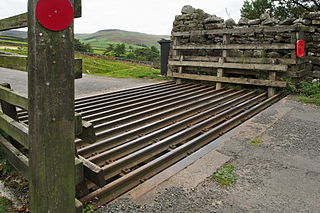
A cattle grid – also known as a stock grid in Australia; cattle guard, or cattle grate in American English; vehicle pass, or stock gap in the Southeastern United States; Texas gate in western Canada and the northwestern United States; and a cattle stop in New Zealand English – is a type of obstacle used to prevent livestock, such as sheep, cattle, pigs, horses, or mules from passing along a road or railway which penetrates the fencing surrounding an enclosed piece of land or border. It consists of a depression in the road covered by a transverse grid of bars or tubes, normally made of metal and firmly fixed to the ground on either side of the depression, so that the gaps between them are wide enough for an animal's feet to enter, but sufficiently narrow not to impede a wheeled vehicle or human foot. This provides an effective barrier to animals without impeding wheeled vehicles, as the animals are reluctant to walk on the grates.

Hedgelaying is a countryside skill that has been practised for centuries, mainly in the United Kingdom and Ireland, with many regional variations in style and technique. Hedgelaying is the process of partially cutting through and then bending the stems of a line of shrubs or small trees, near ground level, without breaking them, so as to encourage them to produce new growth from the base and create a living ‘stock proof fence’. The first description of hedgelaying is in Julius Caesar's Commentaries on the Gallic War, when his army was inconvenienced by thick woven hedges during the Battle of the Sabis in Belgium. Hedgelaying developed as a way of containing livestock in fields, particularly after the acts of enclosure which, in England, began in the 16th century. Today hedges are laid to contain livestock without the need for artificial fences, maintain biodiversity-friendly habitats, promote traditional skills and because of the pleasing visual effect of a laid hedge.

An electric fence is a barrier that uses electric shocks to deter people and/or other animals from crossing a boundary. The voltage of the shock may have effects ranging from discomfort to death. Most electric fences are used for agricultural fencing and other forms of non-human animal control, although they are also used to protect high-security areas such as military installations or prisons, where potentially-lethal voltages may be used. Virtual electric fences for livestock using GPS technology have also been developed.
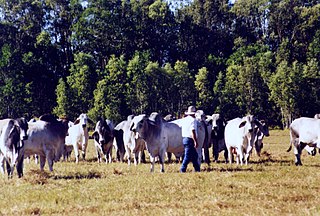
In Australia a stockman is a person who looks after the livestock on a large property known as a station, which is owned by a grazier or a grazing company, traditionally on horse. In this sense it has a similar meaning to "cowboy". A stockman may also be employed at an abattoir, feedlot, on a livestock export ship, or with a stock and station agency.
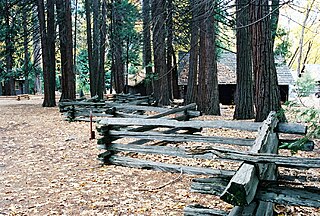
A split-rail fence, log fence, or buck-and-rail fence is a type of fence constructed in the United States and Canada, and is made out of timber logs, usually split lengthwise into rails and typically used for agricultural or decorative fencing. Such fences require much more timber than other types of fences, and so are generally only common in areas where wood is abundant.

A hurdle race in Great Britain and Ireland is a National Hunt horse race where the horses jump over obstacles called hurdles or flights that are over three and a half feet high. They are typically made of a series of panels made of brush and are flexible. Hurdle races always have a minimum of eight hurdles and a minimum distance of two miles (3.2 km).
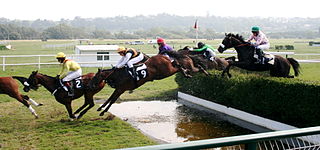
A steeplechase is a distance horse race in which competitors are required to jump diverse fence and ditch obstacles. Steeplechasing is primarily conducted in Ireland, the United Kingdom, Canada, United States, Australia, and France. The name is derived from early races in which orientation of the course was by reference to a church steeple, jumping fences and ditches and generally traversing the many intervening obstacles in the countryside.

A pest-exclusion fence is a barrier that is built to exclude certain types of animal pests from an enclosure. This may be to protect plants in horticulture, preserve grassland for grazing animals, separate species carrying diseases from livestock, prevent troublesome species entering roadways, or to protect endemic species in nature reserves. These fences are not necessarily traditional wire barriers, but may also include barriers of sound, or smell.

A cattle chute or cattle race also called a run or alley, is a narrow corridor built for cattle that separates them from the rest of the herd and allows handlers and veterinarians to provide medical care or restrain the animal for other procedures. A conventional cattle chute consists of parallel panels or fences with a space between them that is slightly wider than one animal so they are unable to turn around. Cattle chutes gently restrain the animal using a squeeze mechanism. The chute is connected to an alley, forming the animals into a queue that only allows them to go forward. Cattle tubs or a BudBox can also be used to help with animal flow and maintain low-stress cattle handling principles. It is used for routine husbandry activities such as drafting (sorting) or loading animals via ramp or loading chute into a vehicle; placing them one at a time in a cattle crush (variations also called a squeeze chute or standing stock) for examination, marking or veterinary treatment. They are also used at packing plants to move animals into a crush designed for slaughter.

A cattle crush, squeeze chute, cattle chute, standing stock, or simply stock is a strongly built stall or cage for holding cattle, horses, or other livestock safely while they are examined, marked, or given veterinary treatment. Cows may be made to suckle calves in a crush. For the safety of the animal and the people attending it, a close-fitting crush may be used to ensure the animal stands "stock still". The overall purpose of a crush is to hold an animal still to minimise the risk of injury to both the animal and the operator while work on the animal is performed.

Wattle and daub is a composite building method used for making walls and buildings, in which a woven lattice of wooden strips called wattle is daubed with a sticky material usually made of some combination of wet soil, clay, sand, animal dung and straw. Wattle and daub has been used for at least 6,000 years and is still an important construction method in many parts of the world. Many historic buildings include wattle and daub construction.
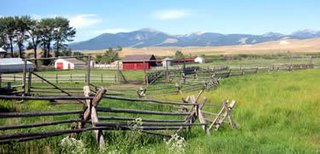
A ranch is an area of land, including various structures, given primarily to ranching, the practice of raising grazing livestock such as cattle and sheep. It is a subtype of farm. These terms are most often applied to livestock-raising operations in Mexico, the Western United States and Western Canada, though there are ranches in other areas. People who own or operate a ranch are called ranchers, cattlemen, or stockgrowers. Ranching is also a method used to raise less common livestock such as horses, elk, American bison, ostrich, emu, and alpaca.

In the Western United States and Canada, open range is rangeland where cattle roam freely regardless of land ownership. Where there are "open range" laws, those wanting to keep animals off their property must erect a fence to keep animals out; this applies to public roads as well. Land in open range that is designated as part of a "herd district" reverses liabilities, requiring an animal's owner to fence it in or otherwise keep it on the person's own property. Most eastern states and jurisdictions in Canada require owners to fence in or herd their livestock.

Wattle is made by weaving flexible branches around upright stakes to form a woven lattice. The wattle may be made into an individual panel, commonly called a hurdle, or it may be formed into a continuous fence. Wattles also form the basic structure for wattle and daub wall construction, where wattling is daubed with a plaster-like substance to make a weather-resistant wall.

Townsville Showground is a heritage-listed showground at 72-104 Ingham Road, West End, City of Townsville, Queensland, Australia. It was added to the Queensland Heritage Register on 16 October 2008.























